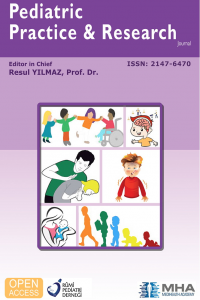Prenatal teratom tanısı almış anterior ve posterior yerleşimli meningomyelosel olgusu
Spinabifida, embriyonik nöral tüpün kapanma defektinin neden olduğu, spinal kord ve vertebranın malformasyonları için kullanılan ortak bir terimdir. Meningomyelosel ise spinal kord ve spinal sinir köklerinin birlikte açıkta kalması ile meydana gelen ve spina bifidanın % 90’ını oluşturan bir malformasyondur. Bu malformasyonların % 90‘ından fazlası multifaktöriyel kalıtımla oluşmaktadır. Hastaların kardeşlerinde benzer tanı ve hikâyelerinde ebeveyn akrabalığı olması hastalığın genetik kalıtımı olduğunu ortaya koymaktadır. Hastalığın tanısı ultrasonografi ile prenatal dönemde konulabilmektedir. Burada anne baba arasında akrabalık bulunmayan ve antenatal dönemde teratom düşünülen ancak postnatal olarak anteroposterior yerleşimli meningomyelosel tanısı alan bir yenidoğan olgu sunulmuştur.
Anahtar Kelimeler:
Nöral tüp defekti, meningomyelosel, hidrosefali, spina bifida
A case of anterior-posterior meningomyelocele which was diagnosed falsely as teratoma during antenatal period
Spina bifida, is a common term for malformations of spinal cord and vertebra caused by in complete fusion of the embryonic neural tube. Meningomyelocele is a malformation that consists 90% of spina bifida and is caused by opening of the spinal cord and spinal nevre roots together. More than 90% of the malformations have multifactorial heredity. Because siblings of the se patients have also similar diagnoses and their parents are relative to each others, it supports a heredity origin of the disease. It can be diagnosed prenatally by the ultrasound. In this paper, we present a case, who born to non-consanguineo us parents, and it was thought as a case of teratoma, but postnatally diagnosed as anteroposterior meningomyelocele.
Keywords:
Neural tube defect, meningomyelocele, hydrocephaly, spina bifida,
___
- 1. Halm YS: Open myelomeningocele. NeurosurgClin N Am 6 (2): 231-241, 19952. Pang D: Surgical complication of open spinal dysraphism. NeurosurgClin N Am 6 (2): 243-257, 19953. BarkovichAJ, Naidich TP: Congenital anomalies of the spine. Barkovich AJ (ed), Pediatric Neuroimaging, New York: RavenPress, 1990: 227-2714. Babcook CJ: Ultrasoundevaluation of prenatal and neonatal spinabifida. NeurosurgClin N Am 6(2): 203-217, 19965. Chambers GK, Cochrane D, lrwin B: Assessment of the appropriateness of services provided by a multidisciplinary meningomyelocele clinic. Pediatr Neurosurg 24: 92-97, 19966. Himmetoglu O, Tiras MB, Gürsoy R: Theincidence of congenital malformations in a Turkish population. Int J GynecolObstet 55: 117-121, 19967. Wald NJ. Folic acid and the prevention of neural-tubedefects. N Engl J Med. 2004;350:101–103.8. Czeizel AE, Dudás I. Prevention of the first occurrence of neuraltubeDefects by periconceptional vitamin supplementation. N Engl J Med 1992; 327:1832-1835.9. Onrat ST, Seyman H, Konuk M. Incidence of neuraltube defects in Afyonkarahisar, Western Turkey. GenetMolRes. 2009;8:154–16110. Northrup H, Volcik KA. Spina bifida and other neuraltube defects. CurrProbl Pediatr. 2000;30:313–332.11. Elliott SP, Villar R, Duncan B. Bacteriuri a management and urological evaluation of patients with spina bifida and neurogenic bladder : a multicenter survey. J Urol. 2005;173:217–220.12. Liptak GS, Dosa NP. Myelomeningocele. Pediatr Rev. 2010;31:443–450.13. Şişli Etfal Hastanesi Tıp Bülteni, Cilt: 44, Sayı: 2, 2010 / The Medical Bulletin of Şişli Etfal Hospital, Volume: 44, Number 2, 2010;61-65
- ISSN: 2147-6470
- Başlangıç: 2013
- Yayıncı: MediHealth Academy Yayıncılık
